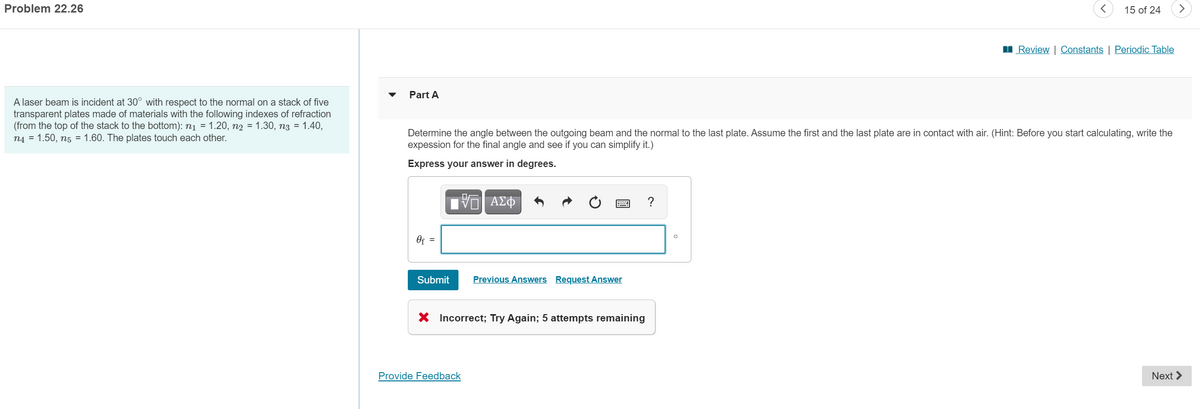I Review | Constants | Periodic Table • Part A A laser beam is incident at 30° with respect to the normal on a stack of five transparent plates made of materials with the following indexes of refraction (from the top of the stack to the bottom): n1 = 1.20, ng = 1.30, ng = 1.40, n4 = 1.50, ng = 1.60. The plates touch each other. Determine the angle between the outgoing beam and the normal to the last plate. Assume the first and the last plate are in contact with air. (Hint: Before you start calculating, write the expession for the final angle and see if you can simplify it.) Express your answer in degrees.
I Review | Constants | Periodic Table • Part A A laser beam is incident at 30° with respect to the normal on a stack of five transparent plates made of materials with the following indexes of refraction (from the top of the stack to the bottom): n1 = 1.20, ng = 1.30, ng = 1.40, n4 = 1.50, ng = 1.60. The plates touch each other. Determine the angle between the outgoing beam and the normal to the last plate. Assume the first and the last plate are in contact with air. (Hint: Before you start calculating, write the expession for the final angle and see if you can simplify it.) Express your answer in degrees.
Physics for Scientists and Engineers with Modern Physics
10th Edition
ISBN:9781337553292
Author:Raymond A. Serway, John W. Jewett
Publisher:Raymond A. Serway, John W. Jewett
Chapter34: The Nature Of Light And The Principles Of Ray Optics
Section34.7: Total Internal Reflection
Problem 34.5QQ
Related questions
Concept explainers
Applications Of Reflection Of Light
When a light ray (termed as the incident ray) hits a surface and bounces back (forms a reflected ray), the process of reflection of light has taken place.
Sign Convention for Mirrors
A mirror is made of glass that is coated with a metal amalgam on one side due to which the light ray incident on the surface undergoes reflection and not refraction.
Question

Transcribed Image Text:Problem 22.26
15 of 24
>
I Review | Constants | Periodic Table
Part A
A laser beam is incident at 30° with respect to the normal on a stack of five
transparent plates made of materials with the following indexes of refraction
(from the top of the stack to the bottom): n1 = 1.20, n2 = 1.30, n3 = 1.40,
n4 = 1.50, n5 = 1.60. The plates touch each other.
Determine the angle between the outgoing beam and the normal to the last plate. Assume the first and the last plate are in contact with air. (Hint: Before you start calculating, write the
expession for the final angle and see if you can simplify it.)
Express your answer in degrees.
ΑΣΦ
Of =
Submit
Previous Answers Request Answer
X Incorrect; Try Again; 5 attempts remaining
Provide Feedback
Next >
Expert Solution
This question has been solved!
Explore an expertly crafted, step-by-step solution for a thorough understanding of key concepts.
This is a popular solution!
Trending now
This is a popular solution!
Step by step
Solved in 2 steps with 2 images

Knowledge Booster
Learn more about
Need a deep-dive on the concept behind this application? Look no further. Learn more about this topic, physics and related others by exploring similar questions and additional content below.Recommended textbooks for you

Physics for Scientists and Engineers with Modern …
Physics
ISBN:
9781337553292
Author:
Raymond A. Serway, John W. Jewett
Publisher:
Cengage Learning

Physics for Scientists and Engineers
Physics
ISBN:
9781337553278
Author:
Raymond A. Serway, John W. Jewett
Publisher:
Cengage Learning

Physics for Scientists and Engineers with Modern …
Physics
ISBN:
9781337553292
Author:
Raymond A. Serway, John W. Jewett
Publisher:
Cengage Learning

Physics for Scientists and Engineers
Physics
ISBN:
9781337553278
Author:
Raymond A. Serway, John W. Jewett
Publisher:
Cengage Learning